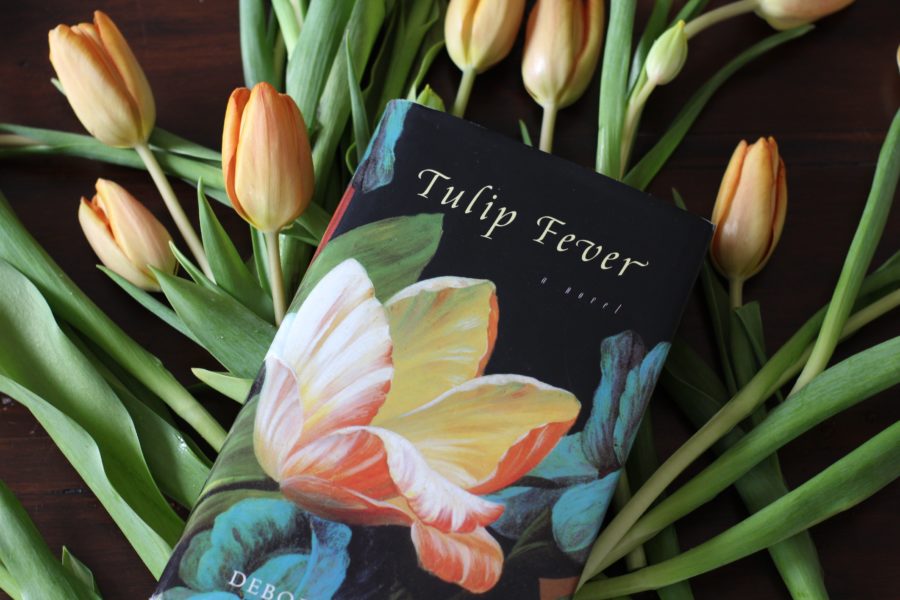I’m a huge fan of the flower still life paintings of the Dutch masters. Whilst my own world tends to be filled with muted tones and neutrals, I find the rich and vivid colours of those flowers set against a dark background, highlighting light and texture, to be just stunning. Hardly surprising then that this book cover would lure me in, not only for that gorgeous tulip but because the pages within seem to promise an historical setting.
The title refers to an interesting in Holland’s economic history. Holland in the 1600s was experiencing a Golden Age. The creation of the Dutch East India Company in 1602, which was financed by shares that created the world’s first modern stock exchange, meant that trade and commerce were booming. By 1630 Amsterdam had become one of the most important ports and commercial centres in the world. The country had a rich agricultural market and a successful fishing industry. Innovations were being made in the world of textiles and journalism was flourishing. Well known for its religious and intellectual tolerance, Holland became a breeding ground for creativity and free thinking, rich in culture and the arts. Maybe it was this unprecedented combination of success and well-being that created the phenomenon known as tulip mania.
The tulip was introduced to Holland from Turkey in 1593 and the Dutch people fell hard for this exotic flower with rich colours, quickly making it a highly coveted luxury item. By 1630 tulip love had reached a fever pitch. For the next 6 years, crazy deals were done in smokey back rooms and bulb growers feverishly grew their wares. Bulbs could change hands many times in one day for large amounts of money. Around this time the tulips contracted a non-fatal virus known as the mosaic virus, which caused the colour of the tulips to split and caused flames of colour to appear on their petals.
 This just contributed to the tulip hysteria. The Semper Augustus bulb was the most coveted of all and could be sold for ten times the annual salary of a skilled labourer. And then, overnight, the market wilted, dropped it’s petals and died, leaving in it’s wake financial catastrophe and ruin which took Holland many years to recover from.
This just contributed to the tulip hysteria. The Semper Augustus bulb was the most coveted of all and could be sold for ten times the annual salary of a skilled labourer. And then, overnight, the market wilted, dropped it’s petals and died, leaving in it’s wake financial catastrophe and ruin which took Holland many years to recover from.
This is the world in which Tulip Fever is set.
The beautiful Sophia is married to wealthy merchant, Cornelis van Sandhoort, almost 40 years her senior. She is not in love with him but she is grateful for the fact that he saved her and her family from poverty after her father died. After three years of marriage and no child, Cornelis seems to choose another route to immortality when he hires painter Jan van Loos to paint the couples’ portrait. It is a fateful decision, for very quickly Jan and Sophia begin a passionate affair that hurtles towards disaster.
Meanwhile, Sophia’s housemaid Maria becomes pregnant and her lover, in a nasty little twist of fate, believes himself betrayed and so takes off on the high seas with nary a word to anyone, leaving behind a distraught Maria. Obligated by societal norms to dismiss her unwed, pregnant maid whom she is very close to, Sophia instead concocts a crazy, convoluted plan that will ultimately help them both out. I don’t want to divulge any more than that for risk of spoiling the plot, suffice it to say that this is a tale that does not end well.
The recklessness shown by Sophia and Jan mirrors the tulip craze that is swirling around them. Indeed, they jump on the bandwagon in a desperate attempt to make a hefty amount of money quickly, in order to help carry out their grand deception.
The book is written in very short chapters from varying characters points of view which moves the book along at a pretty clipped pace. It’s not a heavy read and there is some beautiful prose which I really enjoyed. It is a novel with many levels and the different relationships between the characters, all juxtaposed against one another and the world around them, makes for a great read. And while at it’s heart it is a love story, ultimately, Tulip Fever is about the unintended consequences of passion, greed and deceit when they are all pushed just a little bit too far.

